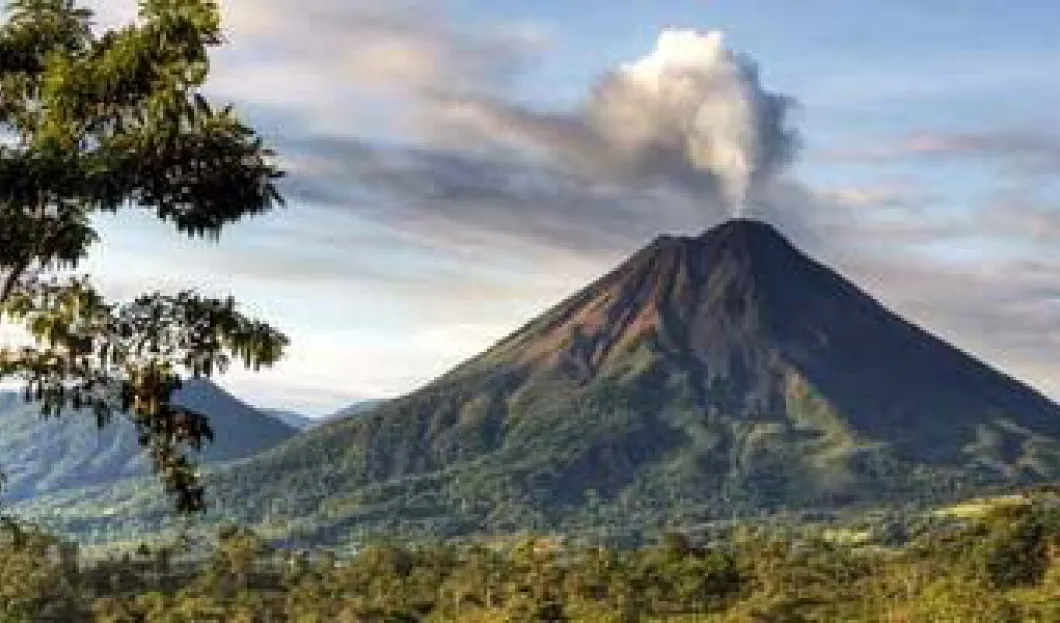
Night creeps through the rainforest, mist descends down the sides of the volcano, wrapping dampness and chill around the encampment of prehistoric men and women. The group peers up at the peak of the mountain, wondering where the glow comes from.
Red boulders tumble and spark down its steep, ashen slopes. One man, the leader, rises up from the huddle; he motions for the others to stay as they are. He takes a heavily husked coconut shell and makes his way up the volcano, braving the potential fury of this thunderous mountain.
He treks up the volcano, scoops up a sizzling, steaming rock into the coconut shell and carries it back to the others. The coconut fibers start to smolder and ignite, working together, the group builds their first fire and chase the chilly night air away.
Costa Rica lies on the east side of the Ring of Fire where four of Earth’s plates converge, creating the conditions for the formation of Andesitic type volcanoes. A flight over Costa Rica reveals a surreal, prehistoric landscape. Volcanoes stretch out like a spine over the green mountainous terrain. There are 600 active volcanoes in the world, 42 of these are in Central America. Costa Rica has 7 active and 60 dormant or extinct volcanoes.
The most famous, active volcano in Costa Rica is Arenal. A visit to the Arenal Volcano is the quintessential volcano experience. Its black conical shape rises imposingly from pristine primary rainforest. Imagine yourself rocking gently in a hammock on the porch of your private cabin, sipping a tropical drink while listening to Howler monkeys calling for the afternoon rain. As the sun sets, the smoking boulders that roll down the steep slopes of Arenal become fiery red, creating a magnificent fireworks display, compliments of Mother Nature.
In the Guanacaste region of Costa Rica you will find three active volcanoes. Rincon de La Viejo (The Corner of the Old Lady) is connected with an old legend. The Guatuso Indians of this region believed there was an old witch who lived at the top of the mountain and sent smoke out of the top when she was angry. The 34,800 acre Rincon de La Vieja National Park could be called the Yellowstone of Costa Rica with its bubbling mud pots, fumaroles, and hot springs.
Miravelles is another volcano. The geothermal activity from this volcano has been harnessed by ICE, the national power company. Tenorio volcano has 4 peaks and 2 twin craters. The Tenorio Volcano National Park is home of the Rio Celeste. Two crystal clear rivers travel down the slopes of Tenorio, when they merge into one larger river, the Rio Celeste, a chemical reaction takes place and the river turns an astonishing blue. Spots along the river have blue sulfur bubbles rising to the surface like floating globes. The Rio Celeste waterfall is the highlight of this magical place.
Around the Central Valley are the Poaz, Irazu and Turrialba Volcanoes. You can drive up to the craters of Poas and Irazu. Poaz has the second widest crater in the world, one mile in diameter. Within the smoking, bubbling cauldron a 300 foot, smoking mini-volcano has formed. Irazu is Costa Rica’s highest volcano reaching 3432 meters above sea level. On clear days, the vista reveals the Atlantic and Pacific Oceans. Its crater is filled with jade green sulfurous water. The Turrialba Volcano has been active since 6300 BC. Costa Rica’s most important archaeological site, Guayabo National Monument, is located in the rainforest at the base of this ancient mountain. This village housed an estimated 1000 people between 1000-1400 AD. A self-guided hike, winds through bird-filled forests and petroglyph carved ruins.
By Debbie Draves Legg










